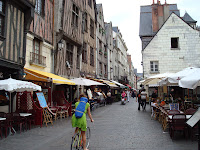Map of Historic Sites in the East Lansing Area of Michigan
 Having just started Nearby History: Exploring the Past Around You, by David E. Kyvig and Myron A. Marty, it came as no surprise that our professor wanted our class to do some exploring of local history. He directed us to the Michigan Historical Center Website, which will search for historical sites by city. In the area around East Lansing, there were a good number of historical homes that were still being lived in, but I felt uncomfortable with the idea of going to check out a house where someone was living. Continuing down the list I found a toll house that was built about halfway through the nineteenth century.
Having just started Nearby History: Exploring the Past Around You, by David E. Kyvig and Myron A. Marty, it came as no surprise that our professor wanted our class to do some exploring of local history. He directed us to the Michigan Historical Center Website, which will search for historical sites by city. In the area around East Lansing, there were a good number of historical homes that were still being lived in, but I felt uncomfortable with the idea of going to check out a house where someone was living. Continuing down the list I found a toll house that was built about halfway through the nineteenth century. It is quite possible that the Alonzo Proctor Tollhouse is the only historic tollhouse left in Michigan. It was originally on the Lansing to Howell plank road that connected Lansing all the way to Detroit, after the state capital was moved to Lansing. The tollhouse, according to the Michigan Historical Center Website, was originally located at 564 North Hagadorn Road in Okemos, MI, but had been moved to Wonch Park, which was also in Okemos. When I went to go see it, it was not there, but instead had been moved from its original location to Meridian Historical Village. That the Michigan Historical Center did not know or did not have the correct location of one of Michigan's historic buildings, I find rather disconcerting.
Meridian Historical Village is a collection of older buildings from the area that have all been moved to this park so that visitors can see them all together. On one hand, this seems like a wonderful on-taking, creating a park where people can go to learn about history, on the other hand, it robs each of these historical buildings of their context. Personally, I find myself torn over whether or not this trad off is worth it.I have always loved going to such historic sites like Greenfield Village, Colonial Michilimackinac, and Colonial Williamsburg, but I also think that there is something extremely special about historic buildings remaining where they were build like Meadowbrook Hall or the Turner-Dodge House.
One question to ask is who is going to see these buildings. Many of the historical parks have programs for schools to take students on field-trips in order to help the children to gain a vague idea of what life was like "way back when." They also have family weekends where the whole family can get involved in learning about history. Many of the places still on their original spots do not appeal to such a wide audience. Some have been converted into offices or private homes and no attempt is being made for their historical merit to be presented to any audience except that of the owners. Other historical landmarks may be recognized as historical in passing, but no one ever learns their stories or their significance. On the MSU campus, for example, there are any number of historical buildings, but few if any of the students could tell you anything more about them than that they are in fact old.
In Kyvig and Marty's book, they discuss the significance of local history being in connecting the history of a particular person, family, object, building, or place to the wider history of the time. How is a specific family representative of the trends of the times? What does an old Victorian mansion tell us about the way people lived, the class system, and the architecture style in a particular region? These are the types of questions we are trying to be able to answer in saving historic buildings and monuments. The question is how best can we do this?












